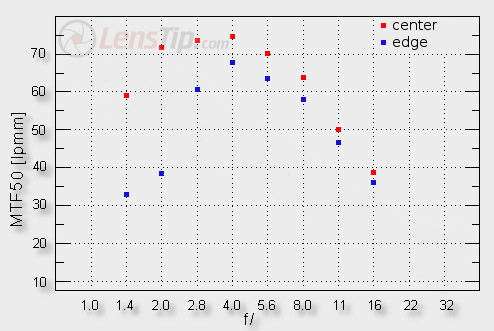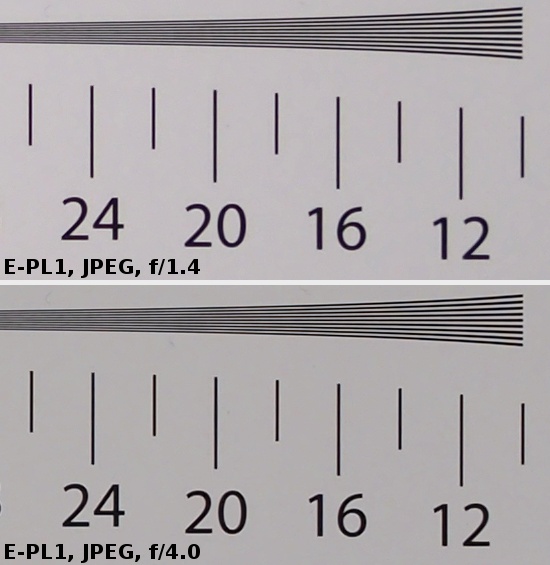Panasonic Leica DG Summilux 25 mm f/1.4 ASPH.
4. Image resolution
In the case of this test it would be the easier to assess the Leica by comparing it to the Voigtlander Nokton 25 mm f/0.95, tested by us before. At the maximum relative aperture the Voigtlander exceeded slightly 30 lpmm, by f/1.4 it got to 53 lpmm and by f/2.0 – 78 lpmm. The peak of its possibilities was reached by f/2.8, where it went a bit higher than 80 lpmm. Now let’s see how the Leica lens compares.

Please Support UsIf you enjoy our reviews and articles, and you want us to continue our work please, support our website by donating through PayPal. The funds are going to be used for paying our editorial team, renting servers, and equipping our testing studio; only that way we will be able to continue providing you interesting content for free. |
- - - - - - - - - - - - - - - - - - - - - - - - - - - - - - - - - - - - - - - - - - - - - - - -
In the case of fast f/1.4 lenses a situation when we get fully useful images already from the maximum relative aperture is rare indeed. Such a feat was accomplished by the previous model of Leica, the 1.4/25, designed for the 4/3 system and, as you can see on a graph above, the new Micro 4/3 version managed to repeat that success. At the maximum aperture we have a splendid result of almost 60 lpmm, so noticeably better than that of the Voigtlander, which, by f/1.4, is, after all, also stopped down by a bit more than 1 EV. It is a great performance indeed. The f/2.0 aperture is equally good, as the lens-plus-body system reaches the resolution level above 70 lpmm. What’s interesting, on further stopping down we don’t see the lens breaking any resolution records because the results by f/2.8 and f/4.0 are placed near 75 lpmm – a level undoubtedly very high but definitely not record-breaking, unlike the performances of the Voigtlander or the Leica 2.8/45. Perhaps it is the price we have to pay for really brilliant results at the maximum aperture. I would like to add it is a price worth paying.
To sum up, the lens deserves a lot of praise. A splendid result at the maximum aperture and a very good performance on further stopping down – you can hardly expect more from an f/1.4 device.
How does the situation look on the edge of the frame? Some reservations you can have about the results at the maximum aperture, where the lens doesn’t get to the decency level. You must admit, though, it comes very close to it. On stopping down to near f/2.2 you see good quality images already on the very edge of the frame. Full frame 1.4/50 lenses can only dream about such results. Overall, despite some reservations, the assessment is definitely positive.
Below, we present some crops of our testing chart, taken from the centre of JPEG files. We would like to remind here that JPEG files were shot with the lowest level of sharpening possible; however, in the case of Micro 4/3 cameras such a level is usually relatively high.
 |






